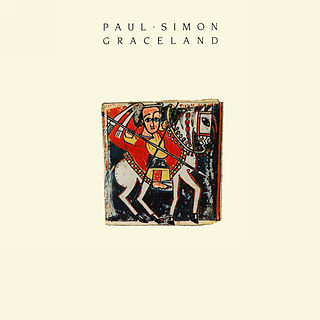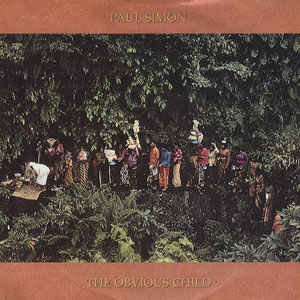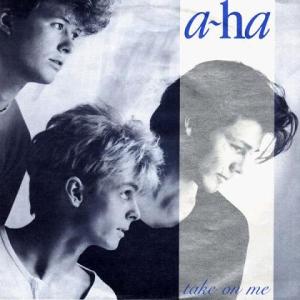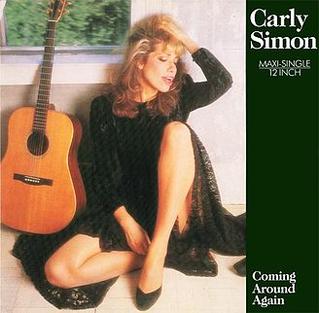
Paul Frederic Simon is an American singer-songwriter known both for his solo work and his collaboration with Art Garfunkel. He and his school friend Garfunkel, whom he met in 1953, came to prominence in the 1960s as Simon & Garfunkel. Their blend of folk and rock, including hits such as "The Sound of Silence", "Mrs. Robinson", "America" and "The Boxer", served as a soundtrack to the counterculture movement. Their final album, Bridge Over Troubled Water (1970), is among the bestselling of all time.

Graceland is the seventh solo studio album by the American singer-songwriter Paul Simon. It was produced by Simon, engineered by Roy Halee and released on August 25, 1986, by Warner Bros. Records. It features an eclectic mixture of genres, including pop, rock, a cappella, zydeco, isicathamiya and mbaqanga, inspired by the music of South Africa.

"Unchained Melody" is a 1955 song with music by Alex North and lyrics by Hy Zaret. North wrote the music as a theme for the prison film Unchained (1955), hence the song title. Todd Duncan sang the vocals for the film soundtrack. It has since become a standard and one of the most recorded songs of the 20th century, most notably by the Righteous Brothers in 1965. According to the song's publishing administrator, over 1,500 recordings of "Unchained Melody" have been made by more than 670 artists, in multiple languages.

"Stand by Me" is a song originally performed in 1961 by American singer-songwriter Ben E. King and written by him, along with Jerry Leiber and Mike Stoller, who together used the pseudonym Elmo Glick. According to King, the title is derived from, and was inspired by, a spiritual written by Sam Cooke and J. W. Alexander called "Stand by Me Father", recorded by the Soul Stirrers with Johnnie Taylor singing lead.

"You Keep Me Hangin' On" is a song written and composed by Holland–Dozier–Holland. It was first recorded in 1966 by American Motown group the Supremes, reaching number one on the Billboard Hot 100. American rock band Vanilla Fudge released a cover version in June the following year, which reached number six on the Billboard Hot 100. Wilson Pickett recorded it in 1969. English singer Kim Wilde covered "You Keep Me Hangin' On" in 1986, reaching number one on the Billboard Hot 100 in June 1987. In the first 32 years of the Billboard Hot 100 rock era, "You Keep Me Hangin' On" became one of the six songs to reach number one by two different musical acts. In 1996, American country singer Reba McEntire's version reached number two on the US Billboard Hot Dance Club Play chart. The BBC ranked the Supremes' original song at number 78 on The Top 100 Digital Motown Chart, which ranks Motown releases by their all-time UK downloads and streams.

"Careless Whisper" is a song recorded by English singer-songwriter George Michael. Released as the second single from Wham!'s second studio album Make It Big (1984), it was written by Michael and Andrew Ridgeley, with Michael producing the song. Although the song was released as part of Make It Big, the single release is credited to either Wham! featuring George Michael or solely to George Michael.

"Don't Dream It's Over" is a song by rock band Crowded House, recorded for their 1986 self-titled debut studio album. The song was composed and written by New Zealand frontman Neil Finn and released in October 1986 as the fourth single from the album.

Surprise is the eleventh solo studio album by American musician Paul Simon, released on May 9, 2006. It peaked at number 14 on the Billboard 200 and was his final studio album for long-time label Warner Bros. Records.

Paul Simon's Concert in the Park is a live album and concert film recorded by Paul Simon as part of his 1991-92 "Born at the Right Time" Tour, with an extensive live backing band comprising top studio and touring musicians as well as a guest appearance at the start by the Brazilian percussion group Olodum. The concert took place in New York City’s Central Park on August 15, 1991, and was broadcast live on the HBO television network as well as being recorded for audio and video release.

"Say You, Say Me" is a song written and recorded by American singer and songwriter Lionel Richie for the film White Nights. The single hit number one on the Billboard Hot 100 and on the Hot Black Singles chart in December 1985. It also became Richie's ninth number-one on the Billboard Adult Contemporary chart. The track is not available on the film's soundtrack album, as Motown did not want Richie's first single following the massive success of his 1983 album Can't Slow Down to appear on another label. It was included by Motown on Richie's 1986 release Dancing on the Ceiling.

"The Obvious Child" is a song recorded by American singer-songwriter Paul Simon. It was the lead single from his eighth studio album, The Rhythm of the Saints (1990), released by Warner Bros. Records. Written by Simon, its lyrics explore mortality and aging. The song is accompanied by a performance from Brazilian drumming collective Olodum in a live recording.

"Love Is the Drug" is a song by the English rock band Roxy Music, from their fifth studio album, Siren (1975), released as a single in September 1975. Co-written by Bryan Ferry and Andy Mackay, the song originated as a slower, dreamier track until the band transformed its arrangement to become more dance-friendly and uptempo. Ferry's lyrics recount a man going out looking for action.

"Graceland" is the title song of the album Graceland, released in 1986 by Paul Simon. The song features vocals by The Everly Brothers. The lyrics follow the singer's thoughts during a road trip to Graceland after the failure of his marriage. Actress and author Carrie Fisher, Simon's ex-wife, said that the song referred in part to their relationship.

"Loves Me Like a Rock" is a song by the American singer-songwriter Paul Simon. It was the second single from his third studio album, There Goes Rhymin' Simon (1973), released on Columbia Records. It features background vocals from the Dixie Hummingbirds, a Southern black gospel group. Although the lyrics are not typically associated with gospel music, the Dixie Hummingbirds were eager to record the song with Simon, and they recorded their own version soon after for their 1973 album We Love You Like a Rock/Every Day and Every Hour.

Paul Simon is an American singer-songwriter who is possibly best known as a member of the folk-duo Simon & Garfunkel with Art Garfunkel. He has released studio albums, live albums, compilation albums and singles. His music career has spanned over 60 years. He started recording music in the 1950s and his most recent album, Seven Psalms, was released on May 19, 2023.

"Take On Me" is a song by the Norwegian synth-pop band a-ha. The original version, recorded in 1984 and released in October of that same year, was produced by Tony Mansfield and remixed by John Ratcliff. The 1985 international hit version was produced by Alan Tarney for the group's debut studio album, Hunting High and Low (1985). The recording combines synth-pop with a varied instrumentation, including acoustic guitars, keyboards, and drums.

"Coming Around Again" is a song by American singer-songwriter Carly Simon, written for the film Heartburn (1986) and later from the album of the same name, Coming Around Again (1987). Released as a single in 1986, it became one of Simon's biggest hits, peaking at No. 18 on the US Billboard Hot 100 and No. 5 on the Billboard Adult Contemporary chart. It was also a top-10 hit in Austria, the Netherlands, Sweden, and the United Kingdom.

"Some Nights" is a song by American indie pop band Fun. It was released on June 4, 2012, as the second single from their second studio album of the same name. The song was written by Jeff Bhasker, Nate Ruess, Andrew Dost, and Jack Antonoff. Musically "Some Nights" is an alternative rock song with elements of power pop and progressive pop while the lyrics depict the protagonist having an existential crisis.

"Diamonds on the Soles of Her Shoes" is a song by the American singer-songwriter Paul Simon. It was the fourth single from his seventh studio album, Graceland (1986), released on Warner Bros. Records. The song features guest vocals from the South African male choral group Ladysmith Black Mambazo.

"The Boy in the Bubble" is a song by the American singer-songwriter Paul Simon. It was the third single from his seventh studio album, Graceland (1986), released on Warner Bros. Records. Written by Simon and Forere Motloheloa, its lyrics explore starvation and terrorism, juxtaposed with wit and optimism.




















